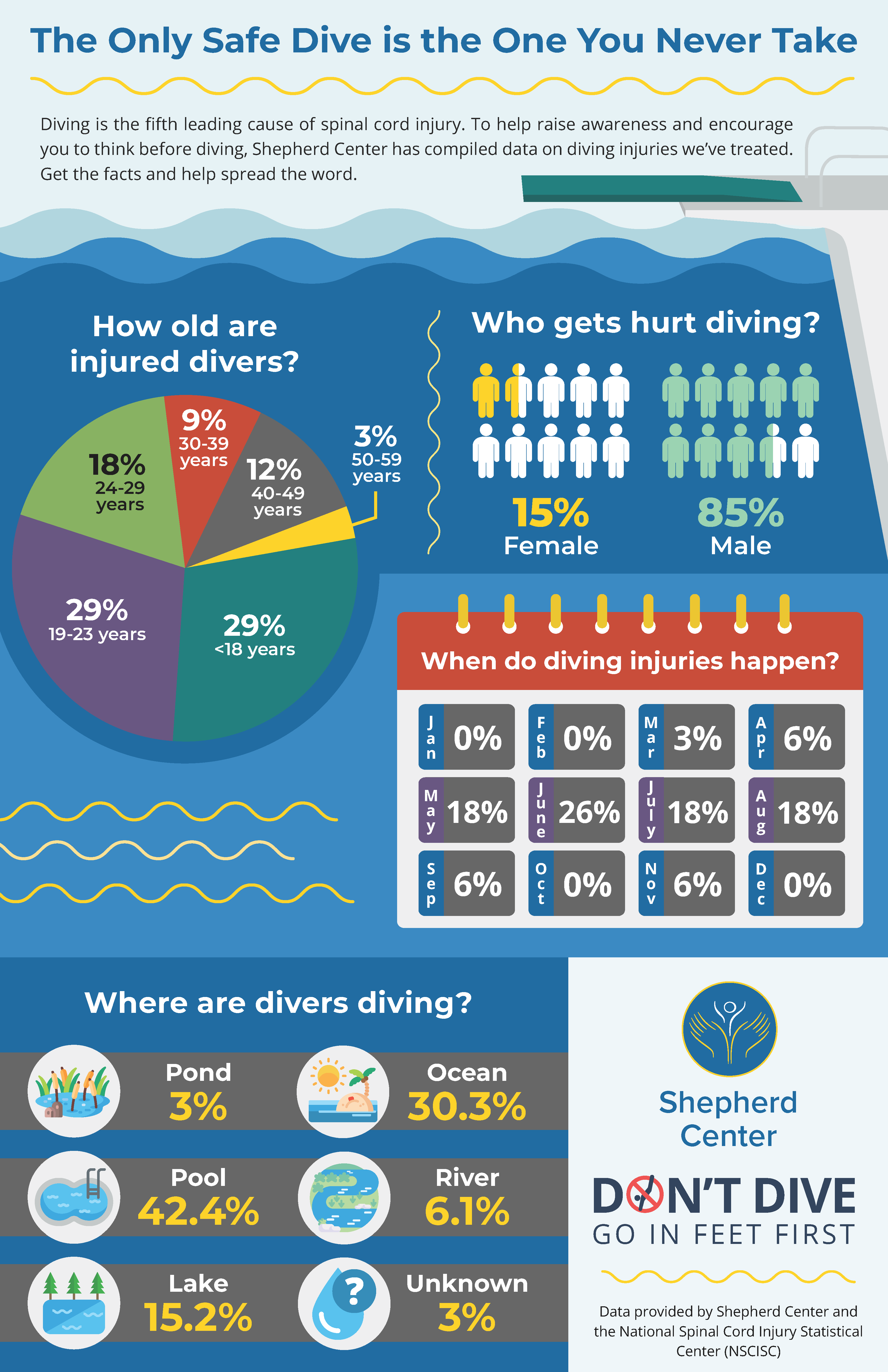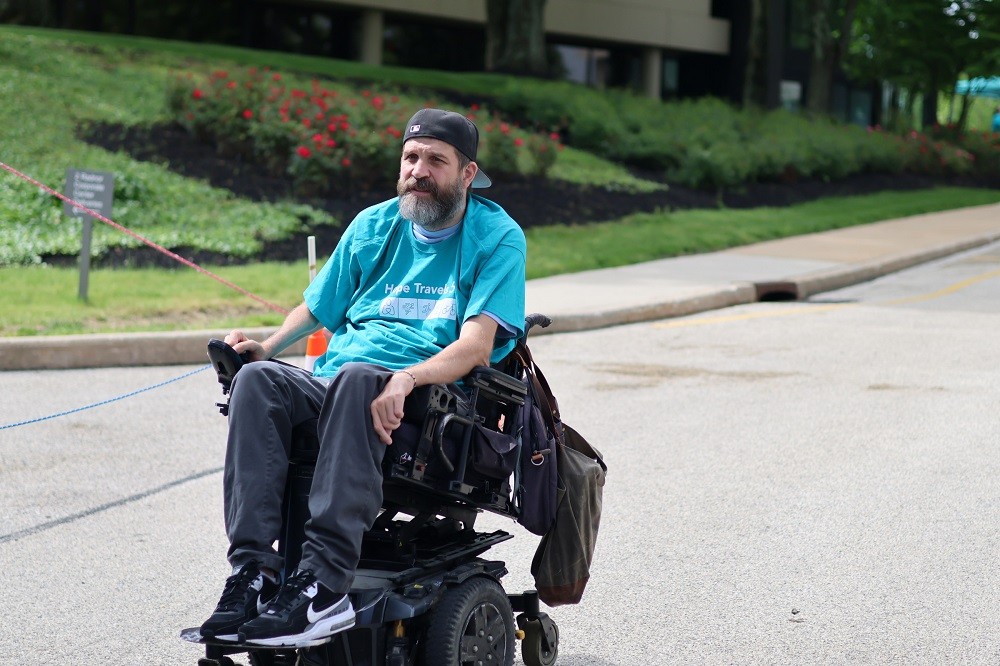Last Updated: June 2024
“The only safe dive is the one you never take,” according to an infographic from Shepherd Center.
Is it true that diving puts you at risk? How serious is the connection between diving and spinal cord injuries?

62% of diving injuries happen in the summer.
Summer months lead the statistics for diving injuries by a wide margin.
That’s why June, July, and August are considered Diving Safety Awareness months.
Here are 5 facts you need to know to keep yourself and your loved ones safe. If you know someone impacted by diving-related paralysis, scroll to the bottom to find resources to help.

Fact 1: Diving is the fifth leading cause of paralyzing spinal cord injuries.
According to Shepherd Center, diving makes the list of the top five causes of spinal cord injuries with paralysis.
85% of individuals who get hurt diving are male and 15% are female.
Most individuals who are injured are between 18 and 29 years old.
Fact 2: There are multiple ways to sustain a spinal cord injury while diving.
There are multiple ways for a dive to end in a spinal cord injury or paralysis based on the location and structure of the spinal cord. The severity of disability depends on the level of the spinal cord where the damage occurs.
The vertebrae of the spine, separated by intervertebral fibrous discs, protects the nervous system’s spinal cord. It is possible to damage the spinal cord by injuring the vertebrae and discs or by injuring the spinal cord itself. “Severe damage to the cord and nerves emerging from the vertebral column will cause paralysis,” reported WHO.
A user forum on Apparelyzed highlighted some of the many ways that diving can lead to a life-altering injury:
“My husband dove into a pool on Labor Day weekend. He is a C4.”
“My spouse dove into a sponge pit. He is now a C5/6.”
“[To me] dives must include anything headfirst, whether it be into lakes, swimming pools, the sea, trampolines or bouncy castles.”
“I made a conscious though foolish decision to launch myself from my patio roof into an above ground pool ten feet away. It was a calculated risk that turned ugly. C5/6 anterior incomplete, with all the bells and whistles.”
“I dove into a surfboard. C7 complete.”
“Dumped on the seabed by a huge wave…C4/5 complete.”
“When you swim competitively, you dive into the pool at the shallow end from a racing block. I was goofing around and dove too deep and hit the bottom.”
“I dove off a 70-foot-high cliff and was fine. Then I dove into a shallow area (of water) from about 6 to 7 feet and hit the sand on the bottom, fracturing my spine at C5/6.”
Fact 3: Water can be deceptive, even if you are a good judge of depth.
Many individuals who sustained a spinal cord injury from diving echo the same reflection:
“I thought I had good perception skills. I thought I could trust myself to stay safe.”
The truth is that water often appears to be deeper than it is, which can lead to devastating errors of judgment even for experienced swimmers and divers.
Fact 4: A single dive can alter your life forever.
Misjudging water depth or diving into unfamiliar waters can lead to severe spinal cord injuries, potentially resulting in paralysis or other permanent disabilities.
Just ask these members of the Help Hope Live community.
They turned to our nonprofit for trusted medical fundraising after diving led to paralyzing spinal cord injuries – and overwhelming out-of-pocket medical expenses.

In 2014, Dillon Connolly was swimming with friends when he performed a simple dive from one area of the water to another. Storms had created a sandbar beneath the water, and the impact shattered Dillon’s C5-C7 vertebrae.
What followed was “the longest year of Dillon’s life,” explained girlfriend Kerry Sheridan. “Immediate surgery, nearly a month of intensive care, three months of intensive physical therapy, occupational therapy, speech therapy, and lifestyle adaptations.”
Dillon explained that being an experienced swimmer isn’t enough to protect you from a dive that can severely alter the rest of your life.
“I swam my entire life competitively,” he explained. “It even paid for college. I broke my neck diving into a wave where the sandy bottom went from deep to too shallow. I tell everyone I meet who asks what happened to never dive unless you can see the bottom, and to tell their kids and friends, too.”

Cole Sydnor was 16 when a diving accident left him paralyzed from the chest down.
“The average person may not understand the extent to which our injuries affect us ‘behind the scenes. Most people…are never exposed to what it takes for [us] to shower, dress, use the restroom, etc,” Cole explained in an interview.
“Those are the hardest parts about living with a spinal cord injury.”
To add to the physical and emotional challenges, spinal cord injuries can come along with a host of out-of-pocket expenses.
“Any medical expenses deemed unnecessary by insurance fall on my family and it becomes their responsibility to make those purchases,” Cole explained. “My elevator, room and bathroom renovation, and truck were all expenses that our community rallied to help fund.”
Today, Cole remains a Help Hope Live medical fundraising client – and he and his wife, Charisma, are content creators with over 1 million subscribers who vlog on YouTube about life with paralysis, interabled and interracial marriage, and more.

Jeff Granger Harris broke his neck diving into the ocean in 2007.
“He ran in to jump over a wave like me and him had done 20,000 times,” explained Jeff’s brother, Greg. Jeff hit his head “at the right angle, at the right speed, at the right tilt of the universe” and became paralyzed.
“Anything you’re used to doing, you can’t do anymore in Jeff’s situation.”
Jeff will face lifelong physical and financial challenges because of a split-second dive. Fundraising has helped him to bridge the gap between what insurance will cover and what he needs for a fulfilling and engaging life.
“This is the only life that I have and I’m going to make the best of it,” Jeff explained.
“Help Hope Live allows you some of that ability through fundraising.”
Jeff’s story:

Lauren Shevchek had been swimming competitively for over a decade. At age 19, she dove into a pool and fractured three cervical vertebrae. She lost feeling from her chest downward.
Lauren worked through months of inpatient rehabilitation to regain some of her independence. She and her family speak publicly about the dangers of diving in order to reduce the number of diving-related injuries.
Janice explained why she is a vocal advocate for diving safety. “Teens in particular are shocked when I mention that paralysis is not just about walking. It’s about losing your ability to urinate and move your bowels on your own,” Janice said:
“Once they begin to understand, they will never forget how devastating the injury is.”
Lauren is now a client Ambassador for Help Hope Live, sharing her story and her experience with spinal cord injury fundraising to help other families.
Fact 5: You can make a difference.
You have a responsibility to keep yourself and your loved ones safe from preventable diving-related spinal cord injuries. Here are a few things you can do right now:
- Educate yourself about safe behaviors and share what you learn with your loved ones.
- Always swim with a lifeguard.
- Enter water feet first, even if you do not plan to dive.
- Don’t dive at all to maximize your chances of preventing injury and paralysis.
“Have the conversations. Never dive headfirst into water you can’t see through, no matter how experienced you are. And don’t ever act on a dare or try risky stunts,” urged Janice Shevchek. “The consequences just aren’t worth it.”
Share Lauren’s slogan with kids:
“If you can’t see through it, don’t dive into it.”
Help Families Impacted by Spinal Cord Injuries
If someone you care about experienced a spinal cord injury due to diving, swimming, or other causes, they may be facing an overwhelming out-of-pocket burden to meet their needs.
Learn about common costs insurance doesn’t fully cover, including ongoing rehabilitation and accessible transportation:
Adjusting to life with paralysis is mentally, physically, and financially draining – but help is here.
As a trusted national nonprofit, Help Hope Live is dedicated to helping individuals address the staggering costs associated with spinal cord injury through caring and compassionate community-based fundraising.
Here’s how you can access medical fundraising help or refer us to a friend:
- Submit a campaign request for assistance
- You’ll be paired with a Client Services Coordinator
- Your Coordinator will provide you with one-on-one fundraising help, including personalized fundraising materials and guidance on how to rally your community, share your story on social media, reach out to the press, plan in-person or virtual fundraising events, and much more
If fundraising isn’t the right fit for you right now, or if you’d like to offer additional trusted resources to a family facing paralysis, turn to our Injury Resource Directory.
Our directory includes hand-selected and vetted resources ranging from support groups to sources of financial grants.
Download the PDF now:
Written by Emily Progin








